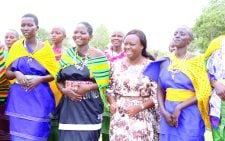Saving the Maasai culture from the verge of extinction

The Maa community, known for their unique warriors and renowned for their vibrant culture, have for long been one of Kenya’s most visible cultural icons.
This distinct communal tribe have long stood as a symbol of traditional resilience in East Africa, attracting tourists who come to witness their traditions and culture, from far and beyond.
However, deep in the plains of Kenya’s Savannah, it seems like the community as well as its culture are facing the threat of extinction.
Traditional practices, like those among the moran (warriors) – those that mark significant life events in the Maasai culture- are slowly fading away.
Lion hunting, which was once one of the community’s prides and where morans earned respect and were crowned with the badge of mighty warriors, can no longer be tenable since it is illegal to hunt regulated wildlife.
More notably, the Empere Naibor, which means the ‘White Spear’, which Morans used, has become extinct, with only a few spears spotted today.
And as the clock continues to tick, the Maa people, in the land of Nasila, have seen the urgent need to preserve their customs and the traditions they have embraced for centuries.
We first meet him sitting under an acacia tree to keep away from the hot sun rays that are scorching mercilessly.
Mzee Keturai Ole Tilalu of the Iseuri age set, lost in nostalgia, recalls their traditions that have seemingly disappeared into thin air in this modern world.
“Many years ago, there was Emurata Etetene and the Emurata Enkedienye, meaning the right and the left initiation rites, which would unite an age set during the Enkinasata Onkirii ceremony where morans graduated to Fatherhood,” he explains.
Mzee Tilalu notes that today, there is nothing like age sets in the first place. According to him, for the past 50 years, the two monumental definitions of age sets in the Maa culture no longer exist.
Finishing age-sets
He narrates that the dissolution of the age set tradition is attributed to a historic war in the community that happened between the Ilterito age set many years ago, which saw many morans from Narok Enterit (present Kajiado South sub-county) killed.
“The naming of the age set was also a unifying factor for all regions of the Maa. One region would be given the task to name an age set. The Ilkisonko sub-tribe, who inhabited the slopes of Mount Kilimanjaro, the present-day Kajiado South and Northern Tanzania, were responsible for the naming,” he explains.
While it was a significant ceremony in the community that acted as a unifying factor, Mzee Tilalu observes that after the war, the age-set naming culture died a natural death.
“Formal education began with the Ilterito Age set, a group of morans who were born in 1890, and by this time, some of the culture had begun to be extinct. The introduction of formal education by “ilmusunku,” the whites, saw some traditions being dropped,” says Mzee Titalu.
More notably, he notes that the popular Maasai manyattas are also on the decline in the Savannahs due to land subdivisions and disposal of their land, adding that rural to urban migration has also played a significant role.
“Those days, there were few common homesteads where many people would stay and live together. But today, some of the community members and the elites have switched to building modern houses and choosing to stay in their own homes, unlike in the past,” Mzee Tilalu explains.
Modern challenges
Even as the Maa culture fades away with every dawn, it still stands out as a distinct culture in Africa and beyond due to its diversity, uniqueness, and its cemented unity, which they hold with honour.
As such, efforts from the Maa people, stakeholders, organisations, and leaders are also working together to preserve the language, promote sustainable tourism, and support Maasai communities in adapting to modern challenges while retaining their cultural identity.
The three Maa governors, Joseph ole Lenku of Kajiado, Patrick ole Ntutu of Narok and Jonathan Leleit of Samburu, started the Maa Cultural Week to promote and celebrate the diverse cultures and foster unity as the strong traditions fade away.
The third edition of the Maa cultural week will be commemorated this year in August to celebrate their unique cultures through diverse cultural performances.















